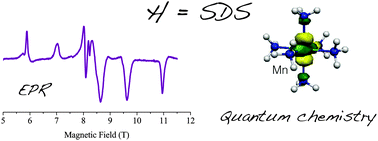Determination and prediction of the magnetic anisotropy of Mn ions†
Abstract
This tutorial is dedicated to the investigation of magnetic anisotropy using both electron paramagnetic resonance (EPR) spectroscopy for its experimental determination and quantum chemistry for its theoretical prediction. Such an approach could lead to the definition of magneto-structural correlation essential for the rational design of complexes with targeted magnetic properties or for the identification of unknown reactive metallic species involved in catalysis. To illustrate this combined approach the high spin MnII, MnIII and MnIV ions have been taken as specific examples. The first part deals with the analysis of the EPR experiments as a function of the ions under investigation and the conditions of the measurements, specifically: (i) EPR spectra recorded under high vs. low frequency conditions with respect to magnetic anisotropy, (ii) EPR spectra of non-integer (Kramers) vs. integer (non-Kramers) spin states and (iii) mono- vs. multi-frequency EPR spectra. In the second part, two main quantum chemical approaches, which have proven their capability to predict magnetic anisotropy, are described. More importantly, these calculations give access to the different contributions of zero field splitting, key information for the full understanding of magnetic anisotropy. The last part demonstrates that such a combined experimental and theoretical approach allows for the definition of magneto-structural correlations.

- This article is part of the themed collection: 7th EuCheMS Chemistry Congress – Molecular frontiers and global challenges


 Please wait while we load your content...
Please wait while we load your content...